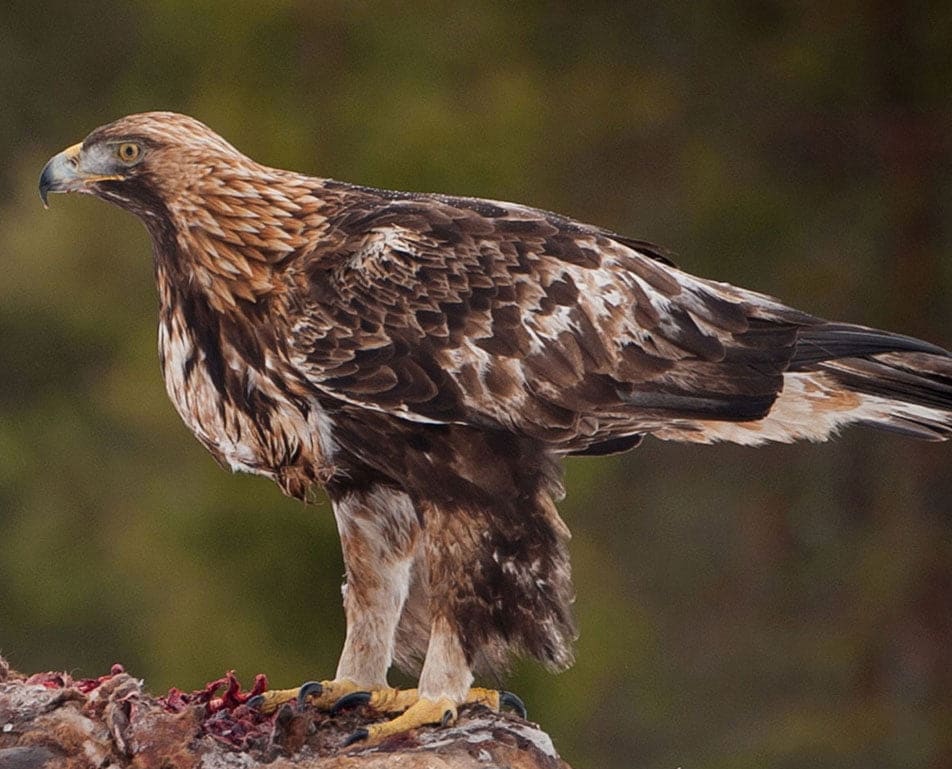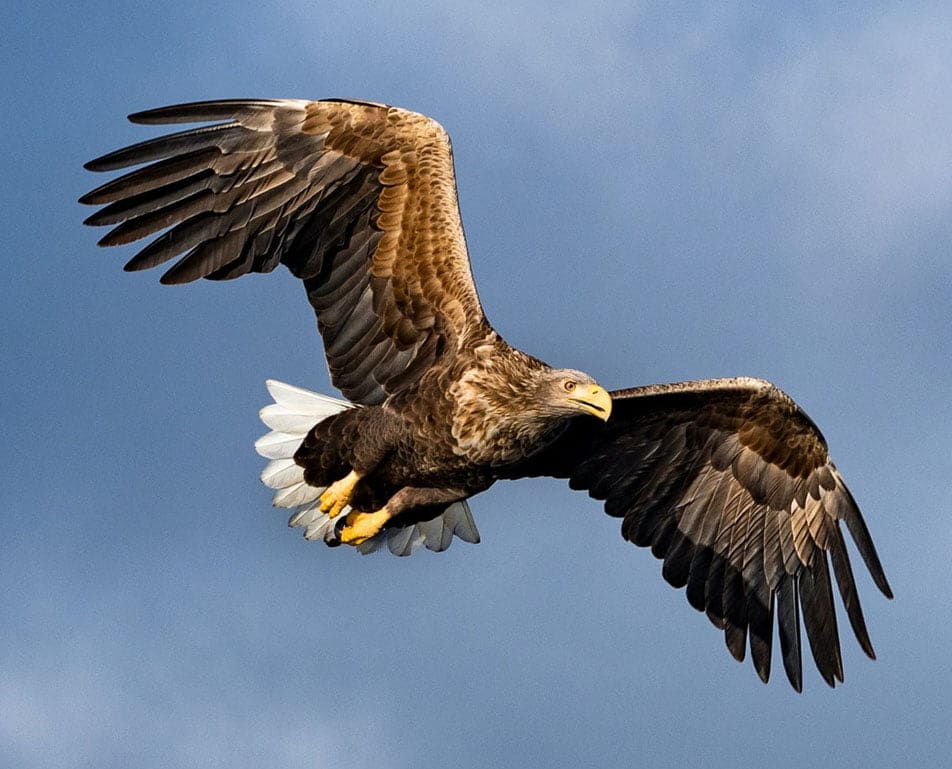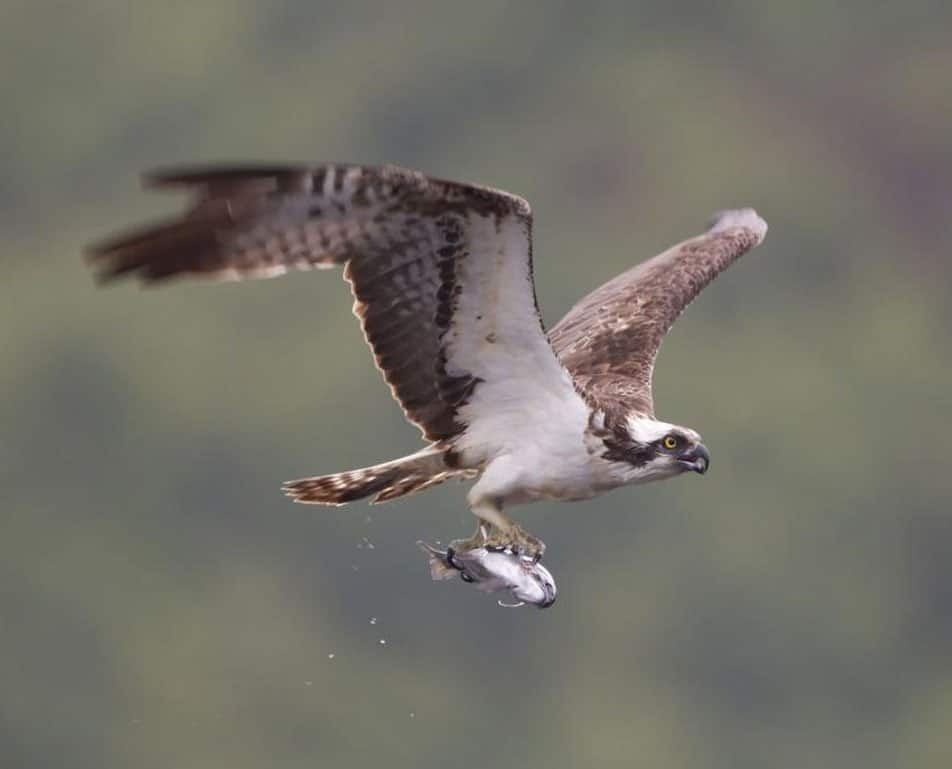Fort William Holiday Lodge
taking flight
Bird Watching Near Fort WilliamThe West Highlands of Scotland present a captivating tapestry of rugged mountains, serene lochs, dramatic coastlines, and expansive moorlands, a landscape that serves as a haven for a remarkable diversity of birdlife. This region stands as a premier destination for those seeking to observe iconic and fascinating avian species in their natural habitats.
From the powerful flight of birds of prey against the skyline to the bustling activity of seabird colonies clinging to the cliffs, the West Highlands offer unparalleled opportunities for avian enthusiasts.
Golden Eagle
The Golden Eagle (Aquila chrysaetos) reigns supreme as an apex predator in this landscape, a truly magnificent bird to behold. Birdwatching tours in the Scottish Highlands often prioritize the chance to observe these majestic creatures. The West Highlands is particularly noted as a rewarding area for Golden Eagle sightings.
Dedicated birdwatching excursions along the West Coast frequently focus on the possibility of encountering these birds in their natural environment. The Isle of Mull boasts the highest breeding density of Golden Eagles in Europe, establishing it as a primary location for those hoping to witness this species. These eagles are present year-round in most of Scotland’s upland forests, including areas within or bordering the West Highlands such as Argyll, Galloway, Glenmore Forest Parks, Mull, Skye, and Glen Affric.
Ecologically, Golden Eagles favor open country, often inhabiting areas around mountains, hills, and cliffs, and sometimes open coniferous forests, habitats readily available in the West Highlands. The prevalence of Golden Eagles throughout the year, coupled with the specific locations and periods of heightened activity, underscores their significance as a key avian attraction in the region.
Dedicated birdwatching excursions along the West Coast frequently focus on the possibility of encountering these birds in their natural environment. The Isle of Mull boasts the highest breeding density of Golden Eagles in Europe, establishing it as a primary location for those hoping to witness this species. These eagles are present year-round in most of Scotland’s upland forests, including areas within or bordering the West Highlands such as Argyll, Galloway, Glenmore Forest Parks, Mull, Skye, and Glen Affric.
Ecologically, Golden Eagles favor open country, often inhabiting areas around mountains, hills, and cliffs, and sometimes open coniferous forests, habitats readily available in the West Highlands. The prevalence of Golden Eagles throughout the year, coupled with the specific locations and periods of heightened activity, underscores their significance as a key avian attraction in the region.

The White-tailed Eagle
The White-tailed Eagle (Haliaeetus albicilla), also known as the Sea Eagle, represents a remarkable conservation success story and is another iconic raptor of the West Highlands. Birdwatching trips along the West Coast often target the observation of both Golden and White-tailed Eagles.
The Isle of Mull stands out as a prime location for encountering White-tailed Eagles, with boat trips offering particularly close-range viewing opportunities.
These eagles prefer sheltered sea lochs, coasts, and inland lochs as their habitat, typically building their nests in trees, a distinction from the Golden Eagle’s preference for rocky crags. They are present throughout the year, and potential sighting locations include Mull, Skye, Ardnamurchan, and the beaches near Arisaig.
The successful reintroduction of this species has solidified its place as a major draw for birdwatchers visiting the West Highlands, particularly around the coastal areas and lochs where they thrive.
The Isle of Mull stands out as a prime location for encountering White-tailed Eagles, with boat trips offering particularly close-range viewing opportunities.
These eagles prefer sheltered sea lochs, coasts, and inland lochs as their habitat, typically building their nests in trees, a distinction from the Golden Eagle’s preference for rocky crags. They are present throughout the year, and potential sighting locations include Mull, Skye, Ardnamurchan, and the beaches near Arisaig.
The successful reintroduction of this species has solidified its place as a major draw for birdwatchers visiting the West Highlands, particularly around the coastal areas and lochs where they thrive.

Osprey
The Osprey (Pandion haliaetus), a magnificent master angler, is another special bird that graces the skies of the Highlands. While RSPB Loch Garten, located in the eastern Highlands near Aviemore, is widely renowned for its breeding Ospreys, these birds can also be found in the West Highlands.
These birds undertake an impressive migration from South Africa, arriving in Scotland starting in April, with the peak time for spotting them being between June and August.
These birds undertake an impressive migration from South Africa, arriving in Scotland starting in April, with the peak time for spotting them being between June and August.

The Merlin
The Merlin (Falco columbarius), a swift and agile hunter, can also be found within the West Highlands. The Isle of Mull is a known location for these small falcons. Additionally, there is a possibility of spotting Merlins in the moorland areas of the far west of the region.
Their preferred habitat aligns well with the diverse landscapes of the West Highlands, as they favor open country including grasslands, seashores, marshlands, and sometimes even coniferous forests. Birdwatchers exploring these open environments have a chance of witnessing the Merlin’s rapid flight and hunting prowess.
Their preferred habitat aligns well with the diverse landscapes of the West Highlands, as they favor open country including grasslands, seashores, marshlands, and sometimes even coniferous forests. Birdwatchers exploring these open environments have a chance of witnessing the Merlin’s rapid flight and hunting prowess.
The Peregrine Falcon
The Peregrine Falcon (Falco peregrinus), celebrated for its breathtaking diving speeds, is another impressive raptor present in the West Highlands.
Similar to the Merlin, the Isle of Mull is a known location for Peregrines. Furthermore, Loch Maree Islands NNR lists the Peregrine Falcon as one of its top bird species.
By scanning the skies above these areas, particularly around cliffs and rugged terrain, observers may be rewarded with the sight of a Peregrine in flight, perhaps even during one of its spectacular dives.
Similar to the Merlin, the Isle of Mull is a known location for Peregrines. Furthermore, Loch Maree Islands NNR lists the Peregrine Falcon as one of its top bird species.
By scanning the skies above these areas, particularly around cliffs and rugged terrain, observers may be rewarded with the sight of a Peregrine in flight, perhaps even during one of its spectacular dives.

Ptarmigan
The Ptarmigan (Lagopus muta), a remarkable master of camouflage, inhabits the high mountain areas of the West Highlands. These birds are a sought-after species for those exploring the Scottish Highlands and can be spotted on the track up to the CIC hut by the north face of Ben Nevis near the house.
Ptarmigan are indeed one of the spectacular birds of the Highlands. They are year-round residents of the high tops of the Scottish Highlands, favoring montane habitats above the treeline. While they typically remain in these high-altitude areas, they may move to the edge of forests during periods of severe winter weather.
Their preferred altitude is generally above 800m. The Ptarmigan undergoes three plumage changes throughout the year, providing exceptional camouflage against the constantly evolving colors of the upland landscape.
Their breeding season commences in late April to early May. The ability of the Ptarmigan to thrive in the harsh conditions of the high mountain environment, coupled with its remarkable camouflage, makes it a truly captivating species to encounter.
Ptarmigan are indeed one of the spectacular birds of the Highlands. They are year-round residents of the high tops of the Scottish Highlands, favoring montane habitats above the treeline. While they typically remain in these high-altitude areas, they may move to the edge of forests during periods of severe winter weather.
Their preferred altitude is generally above 800m. The Ptarmigan undergoes three plumage changes throughout the year, providing exceptional camouflage against the constantly evolving colors of the upland landscape.
Their breeding season commences in late April to early May. The ability of the Ptarmigan to thrive in the harsh conditions of the high mountain environment, coupled with its remarkable camouflage, makes it a truly captivating species to encounter.

Snow Bunting
The Snow Bunting (Plectrophenax nivalis) is an exciting bird that can be found in the high-altitude regions of the West Highlands.
In the Northern Corries of Cairngorm, Snow Buntings are regular in winter, often seen around picnic tables. As the snow melts in spring, they move uphill to breed, and their songs can often be heard during this time. While they breed in small numbers in Scotland, they may have historically bred in the high peaks of Kintail and the Cuillin within the West Highlands, although their numbers in these areas may have declined due to global warming.
The majority of local sightings in the West Highlands tend to occur in winter and likely involve migrant birds from Iceland and Scandinavia. The association of Snow Buntings with these high, often snow-covered environments makes them a unique and interesting species to look for, particularly during the colder months.
In the Northern Corries of Cairngorm, Snow Buntings are regular in winter, often seen around picnic tables. As the snow melts in spring, they move uphill to breed, and their songs can often be heard during this time. While they breed in small numbers in Scotland, they may have historically bred in the high peaks of Kintail and the Cuillin within the West Highlands, although their numbers in these areas may have declined due to global warming.
The majority of local sightings in the West Highlands tend to occur in winter and likely involve migrant birds from Iceland and Scandinavia. The association of Snow Buntings with these high, often snow-covered environments makes them a unique and interesting species to look for, particularly during the colder months.

The Puffin
The Puffin (Fratercula arctica), often called the “clown of the sea” due to its colorful bill, is a highly sought-after seabird that graces the West Highland coast during its breeding season.
These charming birds are a key species to look for in the Scottish Highlands and Islands. Lunga Island, near the Isle of Mull, is a prime location within the West Highlands to see nesting seabirds, including Puffins.
Puffins can generally be seen around the Scottish coast from March to August, with other locations including the Isle of May, Fidra, Craigleith, St Kilda, Orkney, and Shetland.
They nest in burrows on grassy clifftops and spend their winter months at sea. Their breeding period in cliff-top burrows extends from late March to late August, and key West Highland locations include the Isle of Mull (Lunga), the Treshnish Islands (Staffa), and the Shiant Islands.
These charming birds are a key species to look for in the Scottish Highlands and Islands. Lunga Island, near the Isle of Mull, is a prime location within the West Highlands to see nesting seabirds, including Puffins.
Puffins can generally be seen around the Scottish coast from March to August, with other locations including the Isle of May, Fidra, Craigleith, St Kilda, Orkney, and Shetland.
They nest in burrows on grassy clifftops and spend their winter months at sea. Their breeding period in cliff-top burrows extends from late March to late August, and key West Highland locations include the Isle of Mull (Lunga), the Treshnish Islands (Staffa), and the Shiant Islands.

The Black Guillemot
The Black Guillemot (Cepphus grylle), also known locally as the Tystie, is a resident seabird of the West Highland coast and can be found on Mull and the Isle of Rum. These birds breed along rocky ocean coasts and islands, seeking out crevices for their nests. They forage in shallow marine waters near their nesting sites and are largely permanent residents.
The best time to see Black Guillemots is from May to August. The striking black summer plumage of the Black Guillemot, contrasted with the white patch on its wings, makes it a readily identifiable and interesting species to observe along the West Highland shores.
The best time to see Black Guillemots is from May to August. The striking black summer plumage of the Black Guillemot, contrasted with the white patch on its wings, makes it a readily identifiable and interesting species to observe along the West Highland shores.
The Manx Shearwater
The Manx Shearwater (Puffinus puffinus), a long-distance traveler, is another seabird species that can be observed in the West Highlands.
These shearwaters are summer visitors to some of the northern and western isles, nesting offshore in remote locations such as the Isle of Rum, a significant location within the West Highlands.
They can also be spotted from coastal vantage points during their migration from March to October. These birds undertake incredible migratory journeys from South America to breed.
Their distinctive flight, close to the water’s surface, is a characteristic sight of the West Highland seas during the summer months.
These shearwaters are summer visitors to some of the northern and western isles, nesting offshore in remote locations such as the Isle of Rum, a significant location within the West Highlands.
They can also be spotted from coastal vantage points during their migration from March to October. These birds undertake incredible migratory journeys from South America to breed.
Their distinctive flight, close to the water’s surface, is a characteristic sight of the West Highland seas during the summer months.
Buzzard
Buzzards are a frequent sight. They have inhabited mountain ranges, woodlands and moorlands. You will have a good chance of spotting one wherever you go! The picture on the right is taken from the kitchen window.

Bird Species and Where to Spot Them in the West Highlands
| Species | Primary Locations in the West Highlands | Best Time of Year |
|---|---|---|
| Golden Eagle | Isle of Mull, Isle of Skye, West Ross-shire, Glen Affric | Year-round |
| White-tailed Eagle | Isle of Mull, Isle of Skye, Ardnamurchan, Argyll Forest Park | Year-round |
| Osprey | Loch Maree Islands NNR | April-August |
| Ptarmigan | high mountain tops | Year-round |
| Puffin | Isle of Mull (Lunga), Treshnish Isles (Staffa), Shiant Isles, Handa Island | March-August |
| Black Guillemot | Isle of Mull, Isle of Rum, Handa Island | May-August |
| Manx Shearwater | Isle of Rum | March-October |


